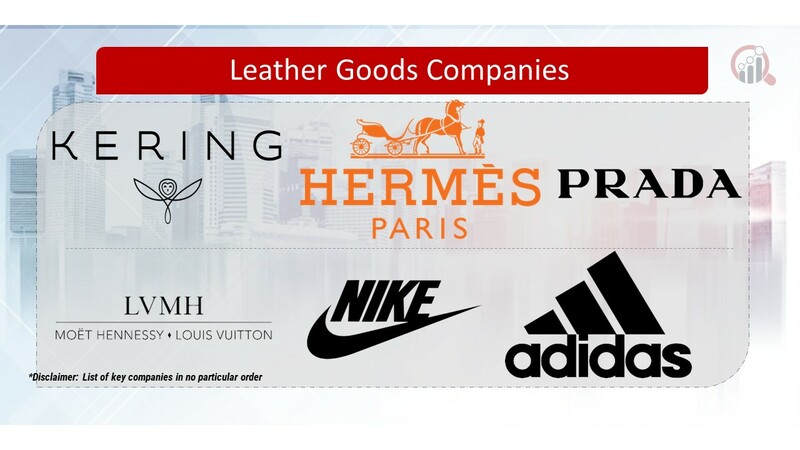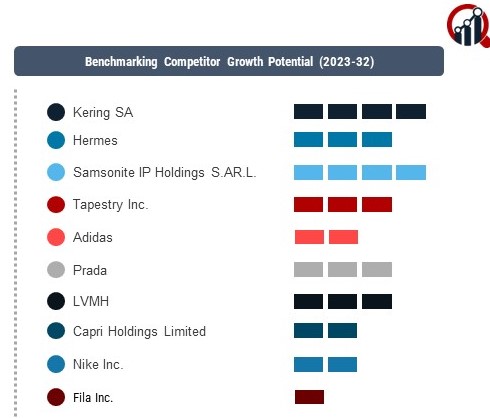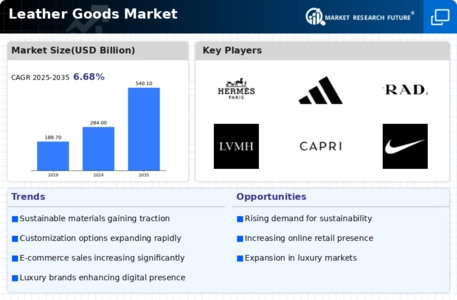Top Industry Leaders in the Leather Goods Market

The leather goods market is a robust and competitive industry, characterized by a diverse range of products and a mix of established and emerging players. As of 2023, key players in this market have been employing various strategies to gain a competitive edge and meet the evolving demands of consumers.
Key Players:
Kering SA,
Hermes,
Samsonite IP Holdings S.AR.L.,
Tapestry Inc.,
Adidas,
Prada,
LVMH,
Capri Holdings Limited,
Nike Inc.,
Fila Inc.,
Strategies Adopted:
The leather goods market adopt various strategies to stay competitive. Differentiation through design innovation is a common approach, with brands continuously introducing new styles and collections to capture consumer attention. Marketing and brand positioning play a crucial role, especially for luxury brands, which often emphasize the exclusivity and craftsmanship of their products. Additionally, expanding product lines to include accessories like wallets, belts, and small leather goods has become a strategy to cater to a broader consumer base.
Market Share Analysis:
The leather goods industry involves considering multiple factors. Brand recognition and reputation are significant contributors, influencing consumers' purchasing decisions. The ability to adapt to changing fashion trends, quality of materials used, and production efficiency are also crucial. Geographical presence and distribution networks play a pivotal role, especially in reaching a diverse global market. Pricing strategies and the balance between exclusivity and accessibility are additional factors influencing market share dynamics.
News & Emerging Companies:
The leather goods market has witnessed the emergence of new players offering innovative designs and targeting niche markets. These emerging companies often focus on sustainable practices and unique selling propositions to distinguish themselves in a crowded market. News related to these companies typically revolves around collaborations with influencers, the launch of limited-edition collections, and their ability to harness e-commerce platforms for increased visibility and sales.
Industry Trends:
The leather goods market often highlights trends in materials, design, and sustainability. Companies are increasingly investing in eco-friendly practices, incorporating sustainable leather alternatives and ethical sourcing into their production processes. E-commerce and digital marketing trends are also notable, with companies investing in online platforms to reach a wider audience and capitalize on the growing trend of online shopping for fashion and accessories.
Investment trends in 2023 reveal a focus on technology integration, with companies exploring smart features in leather goods such as connected accessories or incorporating technology into manufacturing processes. Additionally, collaborations with other industries, such as technology or entertainment, have been observed, showcasing a strategy to tap into different consumer segments and create unique, cross-industry appeal.
Competitive Scenario:
The leather goods market is shaped by the delicate balance between luxury and accessibility. Luxury brands vie for exclusivity and craftsmanship, often at higher price points, while accessible luxury brands focus on reaching a broader consumer base through a combination of quality and affordability. The market is also influenced by fast fashion brands that introduce trendy and affordable leather goods, appealing to a younger and trend-driven demographic.
Competition intensifies as brands explore new markets and distribution channels, with e-commerce playing a pivotal role in reaching consumers globally. Social media and influencer marketing are significant tools employed by companies to enhance brand visibility and connect with the younger, digitally savvy audience.
Recent Development
Coach, in response to the increasing importance of sustainability, announced initiatives to use more environmentally friendly materials in its leather goods. This move aligns with the growing consumer demand for ethically produced and sustainable fashion. Prada, on the other hand, invested heavily in digital marketing campaigns and e-commerce infrastructure, aiming to strengthen its online presence and reach a wider global audience.
Emerging companies made headlines with unique design approaches and sustainable practices, showcasing an industry-wide shift towards more responsible and conscious consumerism. These developments collectively underline the dynamic nature of the leather goods market and the strategies companies employ to stay relevant in a rapidly evolving industry landscape.










